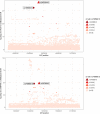This is a preprint.
Genetic Examination of Hematological Parameters in SARS-CoV-2 Infection and COVID-19
- PMID: 35262092
- PMCID: PMC8902884
- DOI: 10.1101/2022.02.28.22271562
Genetic Examination of Hematological Parameters in SARS-CoV-2 Infection and COVID-19
Update in
-
Genetic examination of hematological parameters in SARS-CoV-2 infection and COVID-19.Blood Cells Mol Dis. 2023 Nov;103:102782. doi: 10.1016/j.bcmd.2023.102782. Epub 2023 Jul 20. Blood Cells Mol Dis. 2023. PMID: 37558590 Free PMC article.
Abstract
Background: People hospitalized with COVID-19 often exhibit hematological alterations, such as lower lymphocyte and platelet counts, which have been reported to associate with disease prognosis. It is unclear whether inter-individual variability in baseline hematological parameters prior to acute infection influences risk of SARS-CoV-2 infection and progression to severe COVID-19.
Methods: We assessed the association of blood cell counts and indices with incident SARS-CoV-2 infection and severe COVID-19 in UK Biobank and the Vanderbilt University Medical Center Synthetic Derivative (VUMC SD). Since genetically determined blood cell measures better represent cell abundance across the lifecourse, we used summary statistics from genome-wide association studies to assess the shared genetic architecture of baseline blood cell counts and indices on COVID-19 outcomes.
Results: We observed inconsistent associations between measured blood cell indices and both SARS-CoV-2 infection and COVID-19 hospitalization in UK Biobank and VUMC SD. In Mendelian randomization analyses using genetic summary statistics, no putative causal relationships were identified between COVID-19 related outcomes and hematological indices after adjusting for multiple testing. We observed overlapping genetic association signals between hematological parameters and COVID-19 traits. For example, we observed overlap between infection susceptibility-associated variants at PPP1R15A and red blood cell parameters, and between disease severity-associated variants at TYK2 and lymphocyte and platelet phenotypes.
Conclusions: We did not find convincing evidence of a relationship between baseline hematological parameters and susceptibility to SARS-CoV-2 infection or COVID-19 severity, though this relationship should be re-examined as larger and better-powered genetic analyses of SARS-CoV-2 infection and severe COVID-19 become available.
Conflict of interest statement
Conflict of Interest Statement
The authors declare that they have no competing interests.
Figures





Similar articles
-
Genetic examination of hematological parameters in SARS-CoV-2 infection and COVID-19.Blood Cells Mol Dis. 2023 Nov;103:102782. doi: 10.1016/j.bcmd.2023.102782. Epub 2023 Jul 20. Blood Cells Mol Dis. 2023. PMID: 37558590 Free PMC article.
-
COVID-19 and Thyroid Function: A Bi-Directional Two-Sample Mendelian Randomization Study.Thyroid. 2022 Sep;32(9):1037-1050. doi: 10.1089/thy.2022.0243. Epub 2022 Jul 19. Thyroid. 2022. PMID: 35734897
-
Associations between hematological parameters and disease severity in patients with SARS-CoV-2 infection.J Clin Lab Anal. 2021 Jan;35(1):e23604. doi: 10.1002/jcla.23604. Epub 2020 Nov 13. J Clin Lab Anal. 2021. PMID: 33184946 Free PMC article.
-
SARS-CoV-2 Infection: Differences in Hematological Parameters Between Adults and Children.Int J Gen Med. 2021 Jun 29;14:3035-3047. doi: 10.2147/IJGM.S313860. eCollection 2021. Int J Gen Med. 2021. PMID: 34234532 Free PMC article. Review.
-
Immunological and Hematological Response in COVID-19.Adv Exp Med Biol. 2021;1352:73-86. doi: 10.1007/978-3-030-85109-5_5. Adv Exp Med Biol. 2021. PMID: 35132595 Review.
References
-
- WHO Coronavirus (COVID-19) Dashboard [https://covid19.who.int/]
-
- Henry BM, de Oliveira MHS, Benoit S, Plebani M, Lippi G: Hematologic, biochemical and immune biomarker abnormalities associated with severe illness and mortality in coronavirus disease 2019 (COVID-19): a meta-analysis. Clinical chemistry and laboratory medicine 2020, 58(7):1021–1028. - PubMed
Publication types
Grants and funding
- S10 OD017985/OD/NIH HHS/United States
- UL1 TR000445/TR/NCATS NIH HHS/United States
- U19 HL065962/HL/NHLBI NIH HHS/United States
- S10 RR025141/RR/NCRR NIH HHS/United States
- U01 HG011720/HG/NHGRI NIH HHS/United States
- R01 HD074711/HD/NICHD NIH HHS/United States
- RC2 GM092618/GM/NIGMS NIH HHS/United States
- P50 GM115305/GM/NIGMS NIH HHS/United States
- U01 HG006378/HG/NHGRI NIH HHS/United States
- R01 HL146500/HL/NHLBI NIH HHS/United States
- KL2 TR002490/TR/NCATS NIH HHS/United States
- UL1 RR024975/RR/NCRR NIH HHS/United States
- R01 NS032830/NS/NINDS NIH HHS/United States
- U01 HG004798/HG/NHGRI NIH HHS/United States
- UL1 TR002243/TR/NCATS NIH HHS/United States
LinkOut - more resources
Full Text Sources
Miscellaneous
